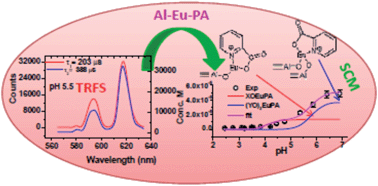当前位置:
X-MOL 学术
›
Environ. Sci.: Processes Impacts
›
论文详情
Our official English website, www.x-mol.net, welcomes your feedback! (Note: you will need to create a separate account there.)
Delineating the influence of picolinic acid on Eu(iii) sorption by γ-alumina.
Environmental Science: Processes & Impacts ( IF 5.5 ) Pub Date : 2020-01-07 , DOI: 10.1039/c9em00287a Madhuri A Patel 1 , Aishwarya Soumitra Kar 1 , Vaibhavi V Raut 1 , S Jeyakumar 1 , Rajnish Singal 2 , B S Tomar 3
Environmental Science: Processes & Impacts ( IF 5.5 ) Pub Date : 2020-01-07 , DOI: 10.1039/c9em00287a Madhuri A Patel 1 , Aishwarya Soumitra Kar 1 , Vaibhavi V Raut 1 , S Jeyakumar 1 , Rajnish Singal 2 , B S Tomar 3
Affiliation

|
The present study aims at understanding the sorption mechanism of Eu(iii) by γ-alumina in the presence of picolinic acid (PA), a decontaminating agent used in the nuclear industry, through batch sorption studies, spectroscopy and surface complexation modeling. PA is weakly sorbed by γ-alumina, with the sorption increasing with pH up to 4.5 and decreasing with further increase in pH. Attenuated Total Reflection-Fourier Transform Infrared Spectroscopy (ATR-FTIR) measurements indicate that PA forms an inner sphere surface complex on γ-alumina. The presence of PA does not affect Eu(iii) sorption by γ-alumina at low [Eu(iii)], while it drastically reduces Eu(iii) sorption at high [Eu(iii)]. Similar Eu(iii) sorption profiles with different addition sequences of Eu(iii) and PA suggest identical Eu(iii) surface species for Eu(iii) sorption on γ-alumina in the presence of PA which has been validated by time resolved fluorescence spectroscopy (TRFS). TRFS measurements of Eu(iii) sorbed on γ-alumina in the absence (binary systems) and presence of PA (ternary systems) exhibited two components 1 & 2. The lifetime value of component 1 in ternary systems is enhanced compared to that in binary systems signifying the formation of new surface species containing Eu(iii), PA and the γ-alumina surface whereas the similarity of component 2 in both the binary and ternary systems reveals an almost identical coordination environment of Eu(iii) in the two types of system. Using the spectroscopic information obtained from TRFS, Eu(iii) sorption, at high [Eu(iii)], in ternary systems has been successfully modeled by considering Eu(iii) bridged PA surface species at both low and high affinity sites of γ-alumina. At low [Eu(iii)] both PA and Eu(iii) bridged ternary surface complexes only at high affinity sites of γ-alumina could describe the Eu(iii) sorption adequately.
中文翻译:

描述了吡啶甲酸对γ-氧化铝吸附Eu(iii)的影响。
本研究旨在通过批吸附研究,光谱学和表面络合模型,了解在吡啶甲酸(PA)存在下,γ-氧化铝在核工业中使用的去污剂中对Eu(iii)的吸附机理。PA被γ-氧化铝微弱地吸附,随着pH值增加到4.5,吸附量增加,而随着pH值的增加,吸附量减少。衰减全反射傅里叶变换红外光谱(ATR-FTIR)测量表明,PA在γ-氧化铝上形成了内球表面复合物。在低[Eu(iii)]下,PA的存在不会影响γ-氧化铝对Eu(iii)的吸附,而在高[Eu(iii)]时则会大大降低Eu(iii)的吸附。具有相似的Eu(iii)和PA添加顺序的相似Eu(iii)吸附曲线表明存在PA时Eu(iii)在γ-氧化铝上的Eu(iii)吸附具有相同的Eu(iii)表面物质,这已通过时间分辨荧光光谱法进行了验证(TRFS)。在不存在(二元体系)和存在PA(三元体系)的情况下,吸附在γ-氧化铝上的Eu(iii)的TRFS测量显示出两个组分1和2。与二元体系相比,组分1在三元体系中的寿命值得到了提高表示形成了包含Eu(iii),PA和γ-氧化铝表面的新表面物种的体系,而二元和三元体系中组分2的相似性表明,两种类型的Eu(iii)的配位环境几乎相同系统。使用从TRFS,Eu(iii)吸附获得的光谱信息,在高[Eu(iii)]下,通过考虑在γ-氧化铝的低和高亲和力位点上的Eu(iii)桥接的PA表面物种,已经成功地建立了三元体系模型。在较低的[Eu(iii)]下,仅在γ-氧化铝的高亲和力位点上,PA和Eu(iii)桥连的三元表面复合物都可以充分描述Eu(iii)的吸附。
更新日期:2020-02-26
中文翻译:

描述了吡啶甲酸对γ-氧化铝吸附Eu(iii)的影响。
本研究旨在通过批吸附研究,光谱学和表面络合模型,了解在吡啶甲酸(PA)存在下,γ-氧化铝在核工业中使用的去污剂中对Eu(iii)的吸附机理。PA被γ-氧化铝微弱地吸附,随着pH值增加到4.5,吸附量增加,而随着pH值的增加,吸附量减少。衰减全反射傅里叶变换红外光谱(ATR-FTIR)测量表明,PA在γ-氧化铝上形成了内球表面复合物。在低[Eu(iii)]下,PA的存在不会影响γ-氧化铝对Eu(iii)的吸附,而在高[Eu(iii)]时则会大大降低Eu(iii)的吸附。具有相似的Eu(iii)和PA添加顺序的相似Eu(iii)吸附曲线表明存在PA时Eu(iii)在γ-氧化铝上的Eu(iii)吸附具有相同的Eu(iii)表面物质,这已通过时间分辨荧光光谱法进行了验证(TRFS)。在不存在(二元体系)和存在PA(三元体系)的情况下,吸附在γ-氧化铝上的Eu(iii)的TRFS测量显示出两个组分1和2。与二元体系相比,组分1在三元体系中的寿命值得到了提高表示形成了包含Eu(iii),PA和γ-氧化铝表面的新表面物种的体系,而二元和三元体系中组分2的相似性表明,两种类型的Eu(iii)的配位环境几乎相同系统。使用从TRFS,Eu(iii)吸附获得的光谱信息,在高[Eu(iii)]下,通过考虑在γ-氧化铝的低和高亲和力位点上的Eu(iii)桥接的PA表面物种,已经成功地建立了三元体系模型。在较低的[Eu(iii)]下,仅在γ-氧化铝的高亲和力位点上,PA和Eu(iii)桥连的三元表面复合物都可以充分描述Eu(iii)的吸附。


























 京公网安备 11010802027423号
京公网安备 11010802027423号